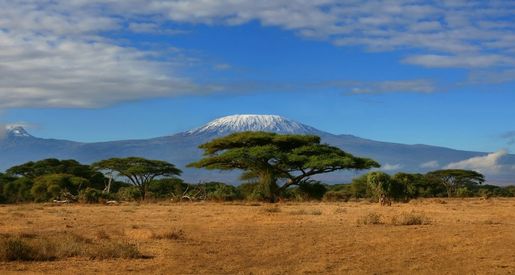- Details
- Category: Knowledge Centre
The Beginner's Guide to climbing kilimanjaro
The ultimate beginner’s guide to taking on the highest summit in Africa.
Climbing Kilimanjaro is no easy task and one heck of a challenge but the views from the famous snow-capped summit are unreal!
So if you’re wondering if climbing Kilimanjaro is for you, we wanted to show you everything you need to know about the much-loved and world-famous ‘Kili’.
Kilimanjaro is not only Africa's tallest peak at 5,895 meters but is also the world's highest freestanding mountain and towers above the sun-baked African plains below.
The history of climbing Kilimanjaro goes way way back to the journey of Hans Meyer, who was the first European to climb Kilimanjaro and summit in 1889. Hans was the first of many who couldn’t resist the allure of the giant volcanic peak and more recently, you’ve probably heard of Johnny Cleggs song ‘Kilimanjaro’(If not, for a little inspiration, give it a listen) as well as the celebrities who climbed Kilimanjaro in the nineties and noughties raising money for charitable causes.
There’s so much about the mountain that draws you in, whether it's the massively varied ecosystems, from lush rainforests to alpine deserts all the way up to the Arctic summit, or the thrill of an African expedition and ticking something epic off your bucket list. There’s something for everyone.
But something that stood out for me when climbing Kilimanjaro were the things other than the mountain. Tanzania itself is an awesome place, especially as you get further away from the towns and into more rural Tanzania. You’re sure to meet lots of smiling Tanzanians with the custom greeting of ‘Jambo’, hello in Swahili or you’ll hear ‘Safari’ which means ‘journey’ and that in a nutshell is what climbing Kilimanjaro is all about, it’s one heck of a ‘Journey’.
As with any treks or adventures that you go on, climbing Kilimanjaro is always more than just the mountain. You’ll experience the laughs and humour of the local Tanzanians where singing and dancing are a huge part of their life. Always an opportunity for you to get involved of course. At night as you sleep in your tent under the stars, you’ll hear the noises of the African wilderness and without doubt fall in love with the place even before you reach the summit.
So if you’re thinking of climbing Kilimanjaro and the process seems a lot to take in, hopefully, this beginner guide to climbing Kilimanjaro will walk you through everything you need to know, get you excited about the trip and also answer some of those niggling questions that you may have before you take on the epic challenge of Kilimanjaro.
So where is Kilimanjaro?
Kilimanjaro is located in northeastern Tanzania in East Africa, pretty close to the Kenyan border and lies about 140 kilometres from Nairobi(Capital of Kenya) and 500 kilometres from Tanzania's capital, Dodoma. The landscape is very diverse, from the hot arid plains at the base of the mountain, all the way to the old summit zone where temperatures can plummet to well below freezing.
How do I get to Mount Kilimanjaro?
One thing that’s great about climbing Kilimanjaro is that it has it’s own airport, Kilimanjaro International Airport (KIA). That’s right! So when you’re looking at flights to Tanzania it’s super easy, just keep a look out for the KIA in any flight comparison sites.
Kilimanjaro International Airport (KIA) has some direct flights from the Uk but most have a stop off in the Middle East. The starting point for your first couple of days in Tanzania is Moshi which is about an hour's drive from KIA airport in Arusha.
When is the best time to climb Kilimanjaro?
When looking at the best time of year to climb Kilimanjaro, some of the things to consider are weather, precipitation, and also the number of people on the mountain! Kilimanjaro lies about 300km south of the equator so Tanzania has wet and dry seasons combined with a hot and muggy climate. So when is the best time to climb Kilimanjaro?
There are wetter and drier months to climb Kilimanjaro, so it’s worth keeping those in mind. We like to time our treks mainly at the beginning of the year in January, February, and the beginning of March, where it's warm on the lower slopes with some rain, colder on the summit nights but also is one of the quietest periods.
Then you are into the summer months of July, August and then September, and October. These two time periods are the driest times of the year for Kilimanjaro and therefore the busiest especially as they coincide with the summer holidays in the UK and Europe - but don’t be fooled, you’ll still have some rain on the lower slopes at ANY time of year!
How difficult is it to climb Kilimanjaro?
Climbing Kilimanjaro is an unbelievable achievement and being one of the seven summits(The 7 highest mountains on the 7 continents) also makes it a proper challenge.
As with any high-altitude summit, it’s all about acclimatisation so taking it slow and letting your body adjust to the altitude. There are several different routes to climb Kilimanjaro ranging from 5 days through to 8 or 9 days with the longer ones having far more success compared to the shorter trips. The biggest challenge on any of these routes is of course the summit night where you’ll be waking up just before midnight, grabbing some food and then heading slowly up for several hours before watching the sun rise from the epic summit of Kilimanjaro.
How long does it take to climb Kilimanjaro?
There are several routes up to the summit itself, some of these as mentioned are shorter trips of 5 days whereas the longer routes take 7 to 9 days.
As mentioned above it’s hugely important to acclimatise and go very slow as you take on the near 6000m summit. Each day can range from 4 to 8 hours of walking until the summit night itself where you’ll be doing 10-12 hours to to the summit and back.
Climbing Kilimanjaro without a guide.
Since 1991, anyone climbing Kilimanjaro is required to be accompanied by a registered and licensed guide, a regulation that ensures both safety and conservation efforts on the mountain. Anyone climbing Kilimanjaro also needs to register with the parks authority before the start of the climb and then sign in at each camping spot as you get higher and higher on the mountain.
Then there are the Park fees to be allowed into Kilimanjaro National Park and to climb Kilimanjaro. While they are seemingly steep(£800 or more per person) this does fund the ongoing conservation efforts as it includes a conservation fee and rescue fee(You never know of course) and provides a safer, more sustainable climbing adventure. This all needs to be done through a company rather than independently.
Of course, whilst climbing Kilimanjaro with us, this is all sorted for you so you can focus on climbing Kilimanjaro and having the best chance of a summit.
How much does it cost to climb Kilimanjaro?
The cost of climbing Kilimanjaro varies a lot ranging from anywhere between £2000 to £5000 depending on the length of the route you choose, what level of guide you have plus some of the more pleasant things like private toilets(Yes we do have these).
Investing in a reputable tour operator not only ensures a safer climb, especially at high altitudes but also ensures fair treatment of the guides and porters you use. There are agencies like KPAP that make sure fair pay for porters and with our team in Tanzania, they also have their own initiative in treating their guides and portes fairly.
The proof is in the pudding where the best guides want to work for the best operators and fortunately, we have a very high level of guide on the mountain.
One of our main guides Yesse Lima has over 400 summits of Kilimanjaro(Imagine that!)and has guided our EverTrek trips since early 2020.
Having a good guide who monitors your experience, weather conditions, manages the porter teams, food, camp setup and everything else gives you the best chance possible of climbing Kilimanjaro, making the summit and getting safely back down again.
How to train for climbing Kilimanjaro
Climbing Kilimanjaro is a tough challenge especially if this is your first taste of altitude. However, we do get a high number of altitude first-timers who summit Kilimanjaro successfully without any issues, even with no large training beforehand. However, it's a big challenge and tends to be very tough for them. On the flip side of that, you get the people who do put in the hours of training and the hard work, some are out hiking all the time and some are already climbing mountains and they have a far more enjoyable experience when making the summit. So in short, the more you can do the better your chance of climbing Kilimanjaro successfully.
Getting out there in the mountains and climbing a few smaller peaks in the build-up to your trip will make a huge difference. In addition, some EverTrekkers do some night hikes or walks so when you get to summit night, it’s something you have experience in already.
What equipment do you need to climb Kilimanjaro?
You’ll likely have all of this equipment if you’ve been on another altitude trek or if you’re already out there walking in the mountains.
- A solid waterproof jacket. Things can get pretty wet when climbing Kilimanjaro, especially on the lower slopes so having a decent waterproof jacket is a must.
- Well worn in hiking boots. You don’t to rock up to climb Kilimanjaro and get those darn blisters do you?!! There are heaps of options out there and once you decide, get out there and use them before your trip.
- , and plenty of thick socks. These should be tried and tested before the hike begins as finding out they are unsuitable and uncomfortable two days in is the last thing you want.
- You’ll need a hiking backpack to carry your daily essentials, 25l to 30l combined with a hydration bladder. We recommend the Osprey Talon 33L if you prefer a specific women’s fit pack, we like the Lowe Alpine Airzone Trail or Osprey Tempest.
- Grab yourself a decent sleeping bag. A 3 to 4 season sleeping bag is fine, anything with a rating of 0 to -10c will be more than adequate for climbing Kilimanjaro. The best sleeping bags are mummy shaped with an insulated hood and that fits the contours of your body. There are some brilliant mummy shaped sleeping bags. We personally suggest Rab, Highlander, Coleman and Mountain Hardwear. Thermals for the cold nights (and some days) hiking.
- Waterproof/windproof trousers and pull over shell, even if you are hiking in the months where its dryer than other, the weather can become cold very quickly. You could also bring shorts especially when you’re in Moshi as it gets pretty warm most of the year.
- A good Down Jacket is a must and needed for when the temperature drops, especially on summit night. The summit can be as cold as -20 degrees Celsius on some summit nights.Brrr but part of the challenge right!
- Beanie and gloves.Get some decent gloves, down-filled always best.
- Sunglasses/suncream are not to be forgotten. At altitude, you’ll feel the effects of increased levels of UV rays more so than at sea level so make sure you use suncream. Plus you don’t want to be squinting all the time so take some decent sunglasses with you
- As with any trek, especially when climbing Kilimanjaro, don’t forget to bring your toothbrush and toothpaste and other toiletries you may need.
- You’ll need a good head torch for summit night and also for wandering
What route is the best for climbing Kilimanjaro?
Marangu Route - 5 Days
Also known as the ‘Coca-Cola’ route, this is not only the fastest route but also the busiest by far. Although busy, this is the only camp with dorm accommodation whereas the rest are camps. The summit success rate of this route is below 50%. Way too quick an ascent for us and unfortunately alot of high altitude problems along this route.
Machame Route - 6 Days
A tougher route than the Marangu but a lot less popular. It’’s good for acclimatisation as you get an extra day or so plus the scenery is beautiful but doesn’t quite reach the same scenic heights of the below Lemosho route as it starts that little bit higher on a different side of Kilimanjaro.
This is certainly known as ‘The long way’( Not as long as the Northern circuit of course) and has by far, the highest summit success rate, 98% on our trips. The scenery along this route is spectacular, from the sounds of the rainforests to the vastness of the volcanic plains before heading over the legendary ‘Barranco Wall’ and then taking on the summit. This is an EverTrekker favourite!
Northern Circuit - 8-9 Days
The Northern Circuit begins not far from the Lemosho route and also crosses the Shira Plateau but misses out on some of the best bits of Kili in our opinion as you miss ‘Barranco Wall’ and the scenic views of Barafu and Karanga camps. Certainly a scenic route but also is most expensive due to its length.
What to do after climbing Kilimanjaro?
Serengeti Safari - Why not spend some time after climbing Kilimanjaro exploring one of the last great wilderness areas on the planet. Strap into the 4x4 Safari vehicle and head deep into the Serengeti National Park whilst trying to spot BIG 5. Not only that but you’ll be camping under the stars listening to the noises of the African savannah.
Zanzibar Beach Holiday - There’s nothing quite like earning some relaxation on a beach after climbing Kilimanjaro and this is how its done Tanzanian style. You’ll head to the beautiful and scenic Island of Zanzibar and have some well-earned downtime whilst exploring the historic Stone Town and chilling on one of the beautiful beaches of Kendwa.
You can add one of these when booking your trek on our website or by speaking to one of our helpful Yetis at 02920 003216.
Keen to get this one ticked off the list, reach out to our team of Yetis right here via the messenger app on the site or click below to start your EverTrekker journey with us today.
Previous Articles
- How to Train for the Everest Base Camp Trek
- How high is Everest Base Camp?
- How much spending money do you need for the Everest Base Camp trek
- What's the accommodation like on an Everest Base Camp trek
- Are showers available on the Everest Base Camp trek?
- What type of toilets are available on an Everest Base Camp Trek






